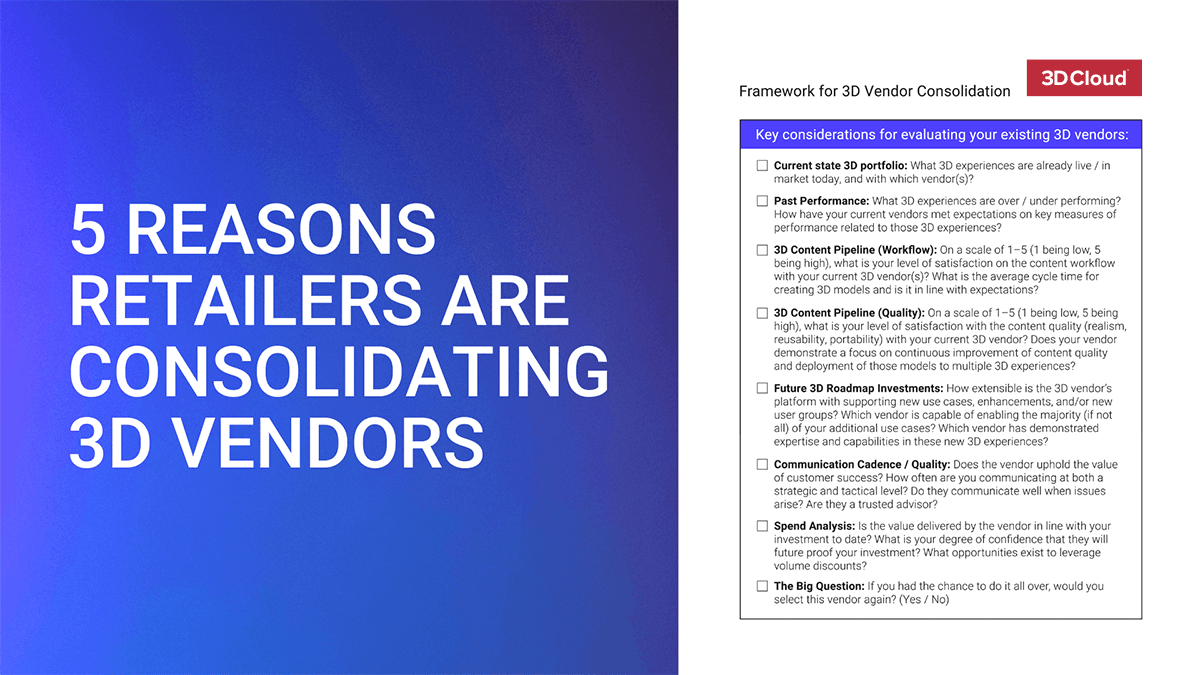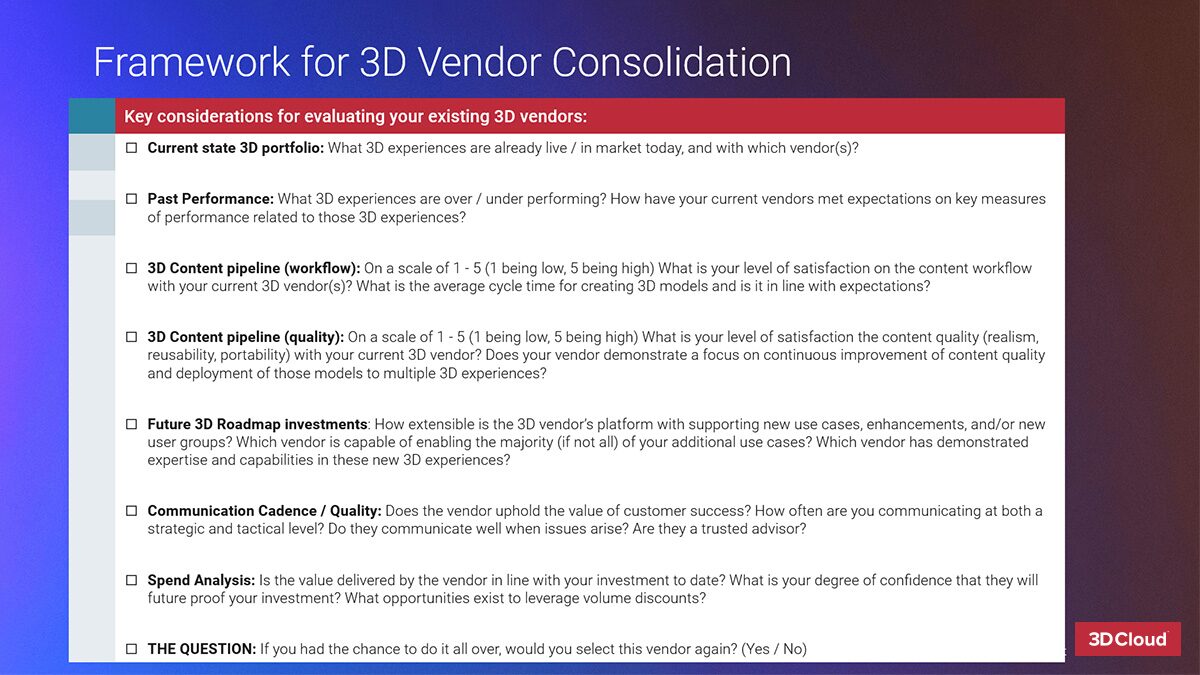
This article covers:
- Reflecting on your 3D strategy: what got you here may (or may not) get you there
- The case for change: Top 5 reasons for considering 3D vendor consolidation
- Managing vendor risk
- Framework for 3D vendor consolidation (free download)
Retailers and manufacturers are rethinking their investments in emerging tech like 3D due to market pressures. For those looking for ways to continue to innovate with 3D while containing costs, a unified approach with a single 3D vendor can help with content costs and future-proof 3D content investments.
If you are a 3D, IT, e-commerce, merchandising or procurement lead responsible for vendor management, this article is for you.
As your 3D strategy changes, so should your approach to 3D vendors
Most companies start out with one 3D point solution, adding more 3D applications as they become available or the business need arises. As your 3D strategy matures and more applications are added to the mix, contracting with multiple 3D vendors for point solutions can become unscalable and costly. It’s time to align your work with your strategy and evolve by looking closely at vendor conslidation.
Top 5 reasons to consolidate 3D vendors
Here are the top 5 reasons that retailers choose 3D vendor consolidation:
- Streamlined workflow: Consolidating 3D vendors simplifies workflows, reduces complexity, and increases efficiency. Assets can be created once and deployed across multiple channels. The process for developing and deploying 3D experiences becomes more predictable and reliable.
- Improved quality control: Consolidating to a single 3D vendor ensures consistent quality standards across all assets and helps establish a single source of truth for 3D content and product data.
- Cost savings: By consolidating 3D vendors, retailers can reduce costs by eliminating content redundancies and leveraging volume discounts. Working with one vendor also simplifies billing, invoicing, and project management, and reduces the need for in-house resources.
- Better collaboration: Working with one 3D vendor enables closer relationships, leading to more successful projects, better outcomes, and a more positive partnership. Organizations avoid the hidden costs of managing multiple vendor relationships.
- Accelerated innovation: Collaboration, trust, and understanding can help retailers bring new innovations to market faster. Retailers and manufacturers can provide their 3D vendor with a deeper understanding of strategic priorities and business imperatives, leading to more tailored solutions. This can also foster new and innovative ideas, understanding emerging trends in 3D technology, and ways to harness these.
Managing vendor risk
Managing vendor risk is crucial in helping organizations limit their potential risks. In supply chain management, it makes sense to diversify vendors to avoid sourcing raw materials or products from a single provider. However, when it comes to 3D experiences, having a reliable 3D vendor with a proven track record of success is essential. A trustworthy vendor should have multiple 3D deployments at an enterprise scale, adhere to security and privacy requirements, and demonstrate strong client ROI. Retailers need a partner who can deliver on their strategic goals and objectives in 3D experiences, both now and in the future.
Framework for 3D vendor consolidation (free download)
We’ve created a free resource to help evaluate existing 3D vendors. Factors to consider include determining if vendor consolidation is necessary. . Note: this is different from our 3D vendor evaluation scorecard which is focused on new 3D vendor selection.
- Current state 3D portfolio: what 3D experiences are currently live and with which vendors?
- Past performance of 3D experiences: How have your vendor(s) performed in past 3D experiences? What is over/under performing?
- 3D content pipeline: How satisfied are you with the content workflow and quality of assets from your 3D vendor(s)? Is there a trend in quality and realism over time? Is the average cycle time for creating 3D models meeting expectations?
- 3D strategy and roadmap: How easily can the 3D platform accommodate new use cases and users? Which vendor can support most or all of your new use cases? Who has shown proficiency in these new 3D experiences?
- Spend analysis: Is the vendor’s value worth the investment, based on their ability to drive growth, save time/costs, and future-proof your 3D investment, rather than simply choosing the cheapest option?
- Communication: Does the vendor prioritize customer success and live up to their values? Are they a trusted advisor with thought leadership in 3D, and how do they communicate when issues arise?
- The most important question: If you had the chance to do it all over, would you choose this vendor again?
Consolidating 3D vendors can benefit organizations by saving time, reducing costs, improving quality, fostering collaboration and innovation, streamlining processes, and providing a consistent customer experience, ultimately leading to improved bottom line and future-proofing of their investment.
Download the Framework for 3D vendor consolidation
Microsoft PPTX | PDF

- Use this tool to assess your current 3D vendor relationships and provide feedback for improvement. Give vendors a chance to respond and make changes as needed.
- Utilize this tool before contract negotiations and vendor consolidation to ensure a smooth transition and minimize business disruption.
- Additionally, use this tool to report to executive leaders on the value of your 3D investments and justify ongoing investment.
If you would like an evaluation of your current state of 3D investment portfolio, Contact Us here or Request a Demo.











